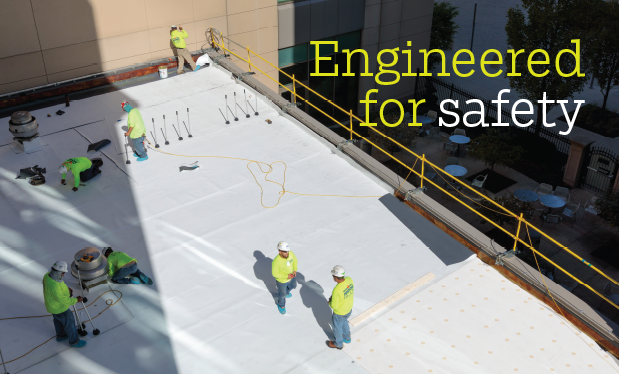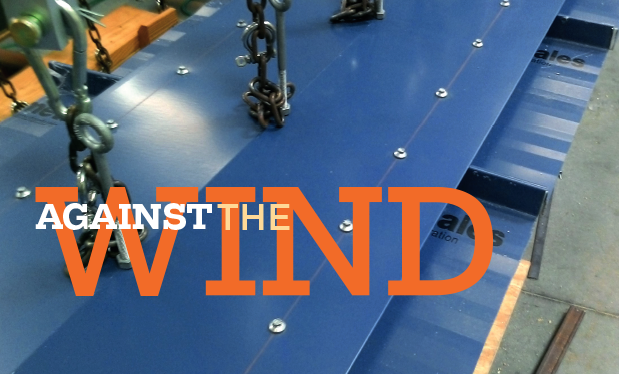The use of metal roofing materials continues to grow for commercial and industrial markets. Their prominence can be attributed to many factors, but research documenting the durability and life span of metal roof systems has been a strong factor. In addition, the metal building industry has matured to provide greater product versatility, such as a variety of substrates, colors and textures that appeal to architects and designers of new construction as well as renovation and historical restoration projects.
Aesthetic possibilities
Beyond a variety of colors and finishes, there are diverse profiles available to meet architects’ unique design requirements. Providing a contiguous steel surface that is waterproof and weathertight, standing-seam metal roof systems remain one of the most popular options for nonresidential projects, according to the Metal Construction Association.
Metal roofing is attractive to architects because there are many aesthetic options to explore—from mechanically seamed panels that can be curved (barrel roofs) to a wide range of radiuses (conical shapes) and applications to continuous interlocking systems that allow for thermal expansion and contraction to help roof lines appear straight. But no matter the application, a metal roof system requires proper design, specification and detailing.
“Architects must choose products that are best suited to the roof’s pitch and geometry, which includes special conditions such as hips, valleys and ridges,” says Todd Miller, president of roofing manufacturer Isaiah Industries, Piqua, Ohio, and a metal roofing expert with more than 30 years of industry experience. “Design considerations include whether the metal roof system will be structural [installed over open framing] or architectural [installed over decking], as well as how water flows on the roof. Then, you can decide on the aesthetics, level of durability and other elements you want to achieve.”
According to MCA, the most common metals used for roofing include steel, aluminum, copper and zinc. To achieve maximum protection, steel must be galvanized or coated while aluminum typically is painted or anodized. Copper is inherently durable and offers an aesthetic patina, and zinc is popular for its corrosion resistance and low-gloss appearance. Metal also is considerably lighter than other materials, affording greater creative opportunities while still delivering sturdiness to accommodate heavy loads and safeguard against damage caused by extreme weather and catastrophic events such as wildfires.
“Metal roofing products are shop-fabricated, which means they are clean, smooth, flat and highly controllable,” notes Wayne Jenski, an architect and enclosure specialist at Dekker/Perich/Sabatini, Albuquerque, N.M. “It also means they are a perfect substrate for new and emerging coatings with impressive properties like high solar reflectance index. That means a cooler roof, which translates to a more easily controlled interior environment and longer service life due to less extreme thermal cycling.”
In commercial applications, vertical or horizontal sheets and panels often are used to achieve bold visual effects. For example, the Park No. 571 boathouse project in Chicago’s Bridgeport neighborhood used a double-lock standing-seam design favored for roof slopes starting at about 5/8:12. Conceptualized by Chicago-based Studio Gang architects, the unique form reflects the movement of rowing through alternating roof trusses made of zinc, which have a slight offset at the top to bring the panel overlaps more into plane and to create a slight reveal.
Many projects also feature stamped-panel metals that simulate the look of shingles or tiles. One example is the Kona International Airport in Kalaoa, Hawaii, where the roof systems have four-way interlocking aluminum panels that provide the appearance of a rustic wood shake. This selection not only matches the natural austerity of the surrounding landscape but also provides the multi-building complex advanced protection against strong coastal winds and flying embers from wildfires.
Proper installation is key
Besides eye-catching aesthetics, architects appreciate the longevity of metal roof systems, which may have nearly twice the life span of conventional roofing products. According to the Metal Roofing Alliance,® you can expect a metal roof system to last two to three times longer than other roofing materials. Metal roof system components may have to be replaced less frequently, but they must be installed properly to achieve optimal longevity.
Long-term planning is essential when it comes to choosing the appropriate trim, fasteners and accessories for metal roof systems. For instance, rooftop penetrations for skylights, fans, rooftop units, hatches and other products must be correctly addressed to avoid roof leaks.
All roof system components also need to be compatible with the furnished roof panel. Additionally, exposed metal components always should be finished to match the panels or trim, and molded closure strips need to be closed-cell or solid-cell synthetic rubber or neoprene or polyvinyl chloride pre-molded to match the configuration of the covering for waterproofing purposes. Thermal spacer blocks and other thermal barriers at concealed clip fasteners should be installed according to manufacturer recommendations.
Also, a metal roof system’s panels and trim never should come into contact with dissimilar materials (copper, lead, graphite, treated lumber, mortar, etc.). The combination could lead to interactions resulting in early degradation or staining or even system failure. An architect’s affinity for such details can help ensure the successful installation of metal roof systems.
Save time and money
Another benefit of using metal in a roof is the material is highly recyclable, which means it can be recycled indefinitely when it requires replacement. When describing metal roofing, insurance company State Farm® states the following on its website: “Metal roofs not only have 25-95% recycled content, depending on the material used, but are also 100% recyclable at the end of their life as a roof. In contrast, most shingle tear-off waste ends up as part of the building-related waste stream—up to 20 billion pounds per year.”
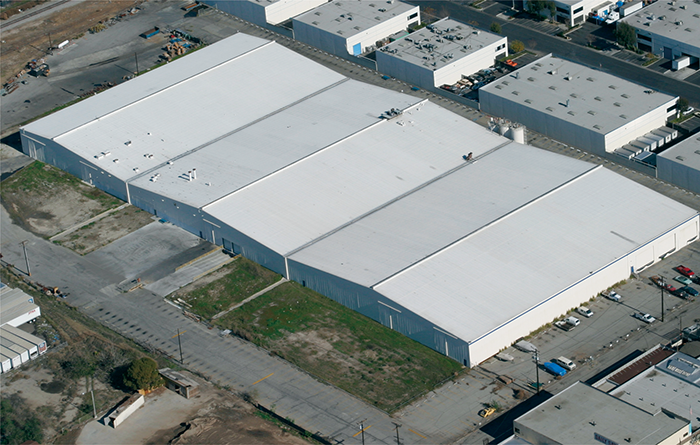 Standing-seam metal roof systems are one of the most popular roof systems used on commercial structures.
Standing-seam metal roof systems are one of the most popular roof systems used on commercial structures.
When metal roof systems reach the end of their serviceable lives, building owners have the option to retrofit, recoat or replace the systems.
In June, an article appearing on designandbuildwithmetal.com, “Metal Roof Rehabilitation: Knowing Whether to Retrofit, Recoat or Replace,” provided several insights about metal roof rehabilitation.
“A metal roof retrofit can provide a vast array of benefits to a building owner,” explains Thomas Diamond, PE, director of product ad systems for The Garland Co. Inc., Cleveland. “In addition to the time savings that can be achieved without having to tear off the existing metal roof, the facility will typically not need to shut down during the installation of a retrofit metal roof.”
Retrofitting also reduces a project’s labor costs because the existing roof panels do not have to be removed.
“The true benefit of this, aside from saving money on the initial installation, is the opportunity to reallocate that saved capital on a high-performance standing-seam metal roof system,” Diamond adds.
Miller brings up another advantage of specifying a metal roof system.
“I think an interesting aspect of metal roofing and other long-lasting building materials right now is how well they address the shortage of labor in the construction industry,” Miller says. “Everyone tends to agree that increasing material and labor costs are the greatest drivers of higher construction costs. Therefore, to protect oneself from ever-increasing construction labor costs, using products that will not need to be replaced in a few years makes every bit of sense.”
Older buildings often are not up to code in terms of roofing assembly insulation. In cases where the existing roof system and underlying deck have severely deteriorated, a complete replacement usually is the best course of action to meet current code requirements. This is essentially what happened on the Bradford County Courthouse restoration project in Towanda, Pa.
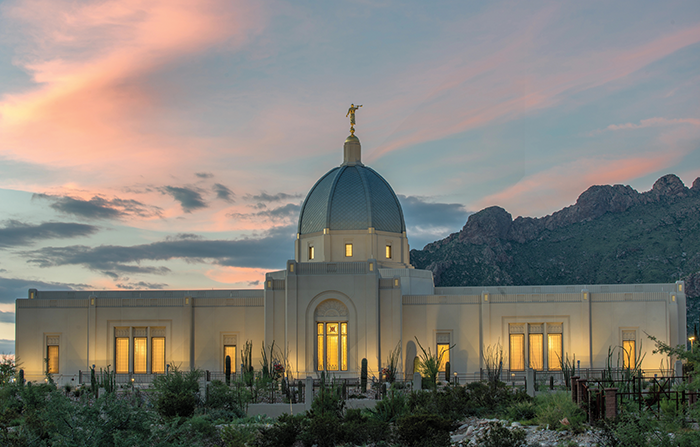 This Mormon temple in Tucson, Ariz., was designed with an interlocking shingle roof system and a dome clad in blue-gray, diamond-patterned tiles.
This Mormon temple in Tucson, Ariz., was designed with an interlocking shingle roof system and a dome clad in blue-gray, diamond-patterned tiles.
Between 2016 and 2018, the copper tiles and clay shingles on the existing roof had to be replaced with a more durable, long-lasting material to withstand the region’s harsh winters and accommodate the main roof’s relatively low slope. Ultimately, the design team selected a batten-seam copper roof system to meet these goals and also match the courthouse’s architectural era from the late 1800s.
“We installed a material that’s going to last an incredibly long time, which we as architects appreciate,” says Michael Jones, RA, an associate and project manager at Hunt EAS, Horseheads, N.Y., the firm that devised the new roof design. “The new roof system’s corrosion-resistant copper will gently change color as it oxidizes over time—demonstrating an evolving beauty few other metals can match.”
“The color we chose not only helped us preserve the historical significance of this iconic landmark but also blended all the building elements together,” adds Gary Henry, a principal at Hunt EAS.
A cool source
Metal roof systems are a great match for photovoltaic panels as the expected service lives of certain metal roof systems recently has shown to be up to 60 years or more, according to a 2014 study co-sponsored by MCA. The research was conducted with oversight of three independent consulting firms.
“The long life of a metal roof system will often outlast the life of the solar panels and eliminate costs and complications of reroofing with an in-place solar grid,” says Vincent Sagan, PE, senior staff engineer for the Metal Building Manufacturers Association.®
MBMA regularly collaborates with other industry partners to promote metal roofing solutions, which complement the inherent structural integrity of metal building systems. Developers are more readily integrating PV panels on facilities, especially in places like California where stringent energy codes are defining the next generation of building design and construction in terms of energy performance and consumption.
One example is Cal Poly Pomona, a polytechnical university in Pomona, Calif., that celebrated the opening of its stunning new student services building earlier this year. General contractor C.W. Driver Companies, Pasadena, Calif., teamed up with CO Architects, Los Angeles, to create a one-of-a-kind undulating roof system that uses solar power to support energy efficiency. Solid and perforated aluminum panels were incorporated into the design scheme to regulate the building’s temperature and overhang up to 30 feet to help shade exterior glass windows, reducing glare and maximizing natural daylight.
Metal roofing’s energy savings also are derived through a variety of “cool pigment” finishes.
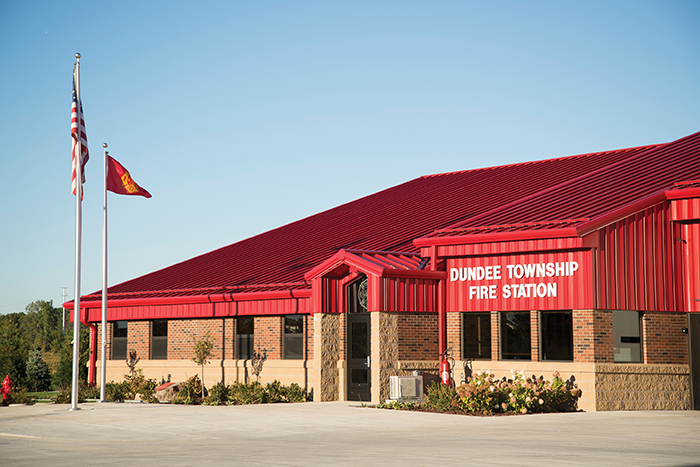 The Dundee Township Fire Station in Michigan features a brilliant red standing-seam metal roof system.
The Dundee Township Fire Station in Michigan features a brilliant red standing-seam metal roof system.
“The premium cool coatings used in metal substrates serve to improve reflectivity, which helps reduce a building’s energy consumption by re-emitting most of the solar radiation it absorbs,” Sagan notes. “These specialized coatings even increase the reflectivity of medium to darker colors at a level that meets the ENERGY STAR® program specifications for cool roofs.”
Research from the Department of Energy shows one additional percentage of reflectivity in a coating, on average, will reduce a roof’s temperature 1 degree.
“We’re seeing advancements in a lot of the finishes being produced,” says Mike Edgell, field supervisor for CentiMark Corp., Canonsburg, Pa. “There are now coatings with better ultraviolet protection, which are ideal for structures in coastal regions, as well as finishes that hold up better with the expansion and contraction of roofs during different seasons.
“As finishes become stronger, they are more applicable to more design criteria. You’ll see architects and engineers wanting to use them more for exterior clad facings and on the envelopes of buildings. Metal looks good, and the enhanced finishes can make the product last longer and look better for greater periods of time.”
Continued inspiration
Future advancements in the metal roofing industry are expected to increase aesthetic possibilities, energy efficiency, longevity and cost savings to benefit building owners. Such innovations should surely continue to impress and inspire architects—and unlock even greater frontiers in design exploration.
Tony Bouquot is general mnager of the Metal Building Manufacturers Association.®
MBMA offers roofing resources
The Metal Building Manufacturers Association® recently teamed up with the North American Insulation Manufacturers Association to develop an acoustical performance guide about metal building roof and wall assemblies, which is available for free download on MBMA’s website, www.mbma.com.

